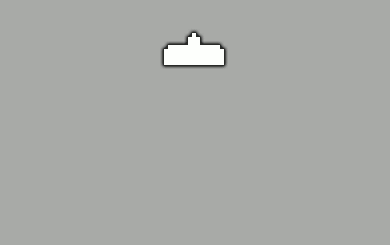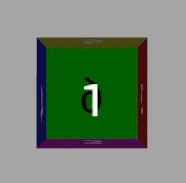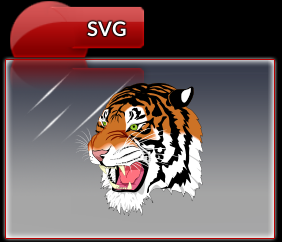RmlUi - now with added boosters taking control of the rocket, targeting your games and applications.
RmlUi is the C++ user interface package based on the HTML and CSS standards, designed as a complete solution for any project's interface needs. It is a fork of the libRocket project, introducing new features, bug fixes, and performance improvements.
RmlUi aims at being a light-weight and performant library with its own layouting engine and few dependencies. In essence, RmlUi takes your HTML/CSS-like source files and turns them into vertices, indices and draw commands, and then you bring your own renderer to draw them. And of course there is full access to the element hierarchy/DOM, event handling, and all the interactivity and customizability you would expect. All of this directly from C++, or optionally from scripting languages using plugins. The core library compiles down to fractions of the size it takes to integrate a fully fledged web browser.
RmlUi is based around the XHTML1 and CSS2 standards while borrowing features from HTML5 and CSS3, and extends them with features suited towards real-time applications. Take a look at the conformance and enhancements sections below for details.
Documentation is located at https://mikke89.github.io/RmlUiDoc/
- Cross-platform architecture: Windows, macOS, Linux, iOS, etc.
- Dynamic layout system.
- Full animation and transform support.
- Efficient application-wide styling, with a custom-built templating engine.
- Fully featured control set: buttons, sliders, drop-downs, etc.
- Runtime visual debugging suite.
- Abstracted interfaces for plugging in to any game engine.
- Decorator engine allowing custom application-specific effects that can be applied to any element.
- Generic event system that binds seamlessly into existing projects.
- Easily integrated and extensible with the Lua scripting plugin.
- The user controls their own update loop, calling into RmlUi as desired.
- The library strictly runs as a result of calls to its API, never in the background.
- Input handling and rendering is performed by the user.
- The library generates vertices, indices, and textures for the user to render how they like.
- File handling and the font engine can optionally be fully replaced by the user.
RmlUi aims to support the most common and familiar features from HTML and CSS, while keeping the library light and performant. We do not aim to be fully compliant with CSS or HTML, in particular when it conflicts with lightness and performance. Users are generally expected to author documents specifically for RmlUi, but any experience and skills from web design should be transferable.
RmlUi supports most of CSS2 with some CSS3 features such as
- Animations and transitions
- Transforms (with full interpolation support)
- Flexbox layout
- Media queries
- Border radius
- Box shadows and mask images
- Gradients (linear, radial, and conic) as decorators
- Filters and backdrop filters (with all CSS filter functions)
and many of the common HTML elements including <input>, <textarea>, and <select>.
For details, see
- RCSS Property index for all supported properties and differences from CSS.
- RML Element index for all supported elements.
RmlUi adds features and enhancements over CSS and HTML where it makes sense, most notably the following.
- Data binding (model-view-controller). Synchronization between application data and user interface.
- Decorators. Full control over the styling of all elements.
- Sprite sheets. Define and use sprites with easy high DPI support.
- Templates. Making windows look consistent.
- Localization. Translate any text in the document.
- FreeType. However, it can be fully replaced by a custom font engine.
- The standard library.
In addition, a C++14 compatible compiler is required.
RmlUi is built using CMake and your favorite compiler, see the building documentation for all the details and options. Windows binaries are also available for the latest release. Most conveniently, it is possible to fetch the library using a dependency manager such as vcpkg or Conan.
vcpkg install rmlui
That's it! See below for details on integrating RmlUi.
To build RmlUi with the included samples we can use git and CMake together with vcpkg to handle dependencies.
vcpkg install freetype glfw3
git clone https://github.com/mikke89/RmlUi.git
cd RmlUi
cmake -B Build -S . --preset samples -DRMLUI_BACKEND=GLFW_GL3 -DCMAKE_TOOLCHAIN_FILE="<path-to-vcpkg>/scripts/buildsystems/vcpkg.cmake"
cmake --build Build
Make sure to replace the path to vcpkg. This example uses the GLFW_GL3 backend, other backends are available as shown below. When this completes, feel free to test the freshly built samples, such as the invaders sample (rmlui_sample_invaders target), and enjoy! The executables should be located somewhere in the Build directory.
To make all the samples available, you can additionally install lua lunasvg rlottie harfbuzz and pass --preset samples-all during CMake configuration.
RmlUi is readily available from ConanCenter.
Here are the general steps to integrate the library into a C++ application, have a look at the integration documentation for details.
- Build RmlUi as above or fetch the binaries, and link it up to your application.
- Implement the abstract render interface, or fetch one of the backends listed below.
- Initialize RmlUi with the interfaces, create a context, provide font files, and load a document.
- Call into the context's update and render methods in a loop, and submit input events.
- Compile and run!
Several samples demonstrate everything from basic integration to more complex use of the library, feel free to have a look for inspiration.
To ease the integration of RmlUi, the library includes many backends adding support for common renderers and platforms. The following terms are used here:
- Renderer: Implements the render interface for a given rendering API, and provides initialization code when necessary.
- Platform: Implements the system interface for a given platform (operating system or window library), and adds procedures for providing input to RmlUi contexts.
- Backend: Combines a renderer and a platform for a complete windowing framework sample, implementing the basic Backend interface.
The provided renderers and platforms are intended to be usable as-is by client projects without modifications, thereby circumventing the need to write custom interfaces. We encourage users to only make changes here when they are useful to all users, and then contribute back to the project. However, if they do not meet your needs it is also possible to copy them into your project for modifications. Feedback is welcome to find the proper abstraction level. The provided system and render interfaces are designed such that they can be derived from and further customized by the backend or end user.
The provided backends on the other hand are not intended to be used directly by client projects, but rather copied and modified as needed. They are intentionally light-weight and implement just enough functionality to make the included samples run, while being simple to understand and build upon by users. See the manual for backend integration details.
| Renderer features | Basic rendering | Transforms | Clip masks | Filters | Shaders | Built-in image support |
|---|---|---|---|---|---|---|
| OpenGL 2 (GL2) | ✔️ | ✔️ | ✔️ | ❌ | ❌ | Uncompressed TGA |
| OpenGL 3 (GL3) | ✔️ | ✔️ | ✔️ | ✔️ | ✔️ | Uncompressed TGA |
| Vulkan (VK) | ✔️ | ✔️ | ❌ | ❌ | ❌ | Uncompressed TGA |
| SDLrenderer | ✔️ | ❌ | ❌ | ❌ | ❌ | Based on SDL_image |
Basic rendering: Render geometry with colors, textures, and rectangular clipping (scissoring). Sufficient for basic 2D layouts.
Transforms: Enables the transform and perspective properties to take effect.
Clip masks: Enables proper clipping of transformed elements, elements with border-radius.
Filters: Support for the filter and backdrop-filter properties with all filter functions, such as blur and drop-shadow.
Shaders: Support for all built-in decorators that require shaders, such as linear-gradient and radial-gradient. Other advanced rendering functions are also implemented, including render-to-texture and masking support for properties such as box-shadow and mask-image.
Built-in image support: This only shows the supported formats built-in to the renderer, users are encouraged to derive from and extend the render interface to add support for their desired image formats.
| Platform support | Basic windowing | Clipboard | High DPI | Comments |
|---|---|---|---|---|
| Win32 | ✔️ | ✔️ | ✔️ | High DPI only supported on Windows 10 and newer. |
| X11 | ✔️ | ✔️ | ❌ | |
| SFML | ✔️ | ❌ | Some issues with Unicode characters in clipboard. | |
| GLFW | ✔️ | ✔️ | ✔️ | |
| SDL | ✔️ | ✔️ | ❌ |
Basic windowing: Open windows, react to resize events, submit inputs to the RmlUi context.
Clipboard: Read from and write to the system clipboard.
High DPI: Scale the dp-ratio of RmlUi contexts based on the monitor's DPI settings. React to DPI-changes, either because of changed settings or when moving the window to another monitor.
| Platform \ Renderer | OpengGL 2 | OpengGL 3 | Vulkan | SDLrenderer |
|---|---|---|---|---|
| Win32 | ✔️ | ✔️ | ||
| X11 | ✔️ | |||
| SFML | ✔️ | |||
| GLFW | ✔️ | ✔️ | ✔️ | |
| SDL¹ | ✔️ | ✔️² | ✔️ | ✔️ |
¹ SDL backends extend their respective renderers to provide image support based on SDL_image.
² Supports Emscripten compilation target.
When building the samples, the backend can be selected by setting the CMake option RMLUI_BACKEND to <Platform>_<RendererShorthand> for any of the above supported combinations of platforms and renderers, such as SDL_GL3.
This example demonstrates a basic document with data bindings, which is loaded and displayed using the C++ code below.
hello_world.rml
<rml>
<head>
<title>Hello world</title>
<link type="text/rcss" href="rml.rcss"/>
<link type="text/rcss" href="window.rcss"/>
</head>
<body data-model="animals">
<h1>RmlUi</h1>
<p>Hello <span id="world">world</span>!</p>
<p data-if="show_text">The quick brown fox jumps over the lazy {{animal}}.</p>
<input type="text" data-value="animal"/>
</body>
</rml>The {{animal}} text and the data-if, data-value attributes represent data bindings and will synchronize with the application data.
window.rcss
body {
font-family: LatoLatin;
font-size: 18px;
color: #02475e;
background: #fefecc;
text-align: center;
padding: 2em 1em;
position: absolute;
border: 2px #ccc;
width: 500px;
height: 200px;
margin: auto;
}
h1 {
color: #f6470a;
font-size: 1.5em;
font-weight: bold;
margin-bottom: 0.7em;
}
p {
margin: 0.7em 0;
}
input.text {
background-color: #fff;
color: #555;
border: 2px #999;
padding: 5px;
tab-index: auto;
cursor: text;
box-sizing: border-box;
width: 200px;
font-size: 0.9em;
}RmlUi defines no styles internally, thus the input element is styled here, and rml.rcss is included for proper layout of common tags.
main.cpp
#include <RmlUi/Core.h>
class MyRenderInterface : public Rml::RenderInterface
{
// RmlUi sends vertices, indices and draw commands through this interface for your
// application to render how you'd like.
/* ... */
}
struct ApplicationData {
bool show_text = true;
Rml::String animal = "dog";
} my_data;
int main(int argc, char** argv)
{
// Initialize the window and graphics API being used, along with your game or application.
/* ... */
MyRenderInterface render_interface;
// Install the custom interfaces.
Rml::SetRenderInterface(&render_interface);
// Now we can initialize RmlUi.
Rml::Initialise();
// Create a context to display documents within.
Rml::Context* context =
Rml::CreateContext("main", Rml::Vector2i(window_width, window_height));
// Tell RmlUi to load the given fonts.
Rml::LoadFontFace("LatoLatin-Regular.ttf");
// Fonts can be registered as fallback fonts, as in this case to display emojis.
Rml::LoadFontFace("NotoEmoji-Regular.ttf", true);
// Set up data bindings to synchronize application data.
if (Rml::DataModelConstructor constructor = context->CreateDataModel("animals"))
{
constructor.Bind("show_text", &my_data.show_text);
constructor.Bind("animal", &my_data.animal);
}
// Now we are ready to load our document.
Rml::ElementDocument* document = context->LoadDocument("hello_world.rml");
document->Show();
// Replace and style some text in the loaded document.
Rml::Element* element = document->GetElementById("world");
element->SetInnerRML(reinterpret_cast<const char*>(u8"🌍"));
element->SetProperty("font-size", "1.5em");
bool exit_application = false;
while (!exit_application)
{
// We assume here that we have some way of updating and retrieving inputs internally.
if (my_input->KeyPressed(KEY_ESC))
exit_application = true;
// Submit input events such as MouseMove and key events (not shown) to the context.
if (my_input->MouseMoved())
context->ProcessMouseMove(mouse_pos.x, mouse_pos.y, 0);
// Update the context to reflect any changes resulting from input events, animations,
// modified and added elements, or changed data in data bindings.
context->Update();
// Prepare the application for rendering, such as by clearing the window. This calls
// into the RmlUi backend interface, replace with your own procedures as appropriate.
Backend::BeginFrame();
// Render the user interface. All geometry and other rendering commands are now
// submitted through the render interface.
context->Render();
// Present the rendered content, such as by swapping the swapchain. This calls into
// the RmlUi backend interface, replace with your own procedures as appropriate.
Backend::PresentFrame();
}
Rml::Shutdown();
return 0;
}Users can now edit the text field to change the animal. The data bindings ensure that both the document text as well as the application string my_data.animal are automatically modified accordingly.
Game interface from the 'invader' sample

Simple game from the 'data_binding' sample

Applying filters in the 'effects' sample

Video demonstration of the 'effects' sample
effects.sample.-.2024-02-05.webm
Killing Time: Resurrected by Nightdive Studios and Ziggurat Interactive - remastered version of the classic shooter game - user interface made with RmlUi

alt:V installer - a multiplayer client for GTA:V

Unvanquished - a first-person shooter game with real-time strategy elements - menus and HUD in RmlUi

Installer software by @xland

TruckersMP - a multiplayer mod for truck simulators - chat box and player panel in RmlUi


Form controls from the 'demo' sample

Sandbox from the 'demo' sample, try it yourself!

Visual testing framework - for built-in automated layout tests

Animations and transitions from the 'animation' sample
animation_sample.webm
Transitions and transforms on a game menu
game_main_menu.webm
Camera movement in a game menu
game_menu_transform.webm
Transitions on mouse hover (entirely in RCSS)

Animated transforms (entirely in RCSS)

Vector animations with the Lottie plugin

Vector images with the SVG plugin

See the full gallery for more screenshots and videos of the library in action.
RmlUi is published under the MIT license. The library includes third-party source code and assets with their own licenses, as detailed below.
MIT License
Copyright (c) 2008-2014 CodePoint Ltd, Shift Technology Ltd, and contributors
Copyright (c) 2019-2024 The RmlUi Team, and contributors
Permission is hereby granted, free of charge, to any person obtaining a copy of this software and associated documentation files (the "Software"), to deal in the Software without restriction, including without limitation the rights to use, copy, modify, merge, publish, distribute, sublicense, and/or sell copies of the Software, and to permit persons to whom the Software is furnished to do so, subject to the following conditions:
The above copyright notice and this permission notice shall be included in all copies or substantial portions of the Software.
THE SOFTWARE IS PROVIDED "AS IS", WITHOUT WARRANTY OF ANY KIND, EXPRESS OR IMPLIED, INCLUDING BUT NOT LIMITED TO THE WARRANTIES OF MERCHANTABILITY, FITNESS FOR A PARTICULAR PURPOSE AND NONINFRINGEMENT. IN NO EVENT SHALL THE AUTHORS OR COPYRIGHT HOLDERS BE LIABLE FOR ANY CLAIM, DAMAGES OR OTHER LIABILITY, WHETHER IN AN ACTION OF CONTRACT, TORT OR OTHERWISE, ARISING FROM, OUT OF OR IN CONNECTION WITH THE SOFTWARE OR THE USE OR OTHER DEALINGS IN THE SOFTWARE.
See Include/RmlUi/Core/Containers/LICENSE.txt - all MIT licensed.
See Source/Debugger/LICENSE.txt - SIL Open Font License.
See
- Samples/assets/LICENSE.txt
- Samples/basic/bitmap_font/data/LICENSE.txt
- Samples/basic/harfbuzz/data/LICENSE.txt
- Samples/basic/lottie/data/LICENSE.txt
- Samples/basic/svg/data/LICENSE.txt
See Backends/RmlUi_Vulkan/LICENSE.txt - MIT licensed.



